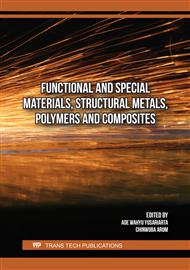[1]
D.R. and B.S.I. Gibson, Additive Manufacturing Technologies: 3D Printing, Rapid Prototyping, and Direct Digital Manufacturing Second Edition, Second Edi. New York: Springer, 2010.
DOI: 10.1007/978-1-4939-2113-3
Google Scholar
[2]
S. C. Ligon, R. Liska, J. Stampfl, M. Gurr, and R. Mülhaupt, "Polymers for 3D Printing and Customized Additive Manufacturing," Chemical Reviews, vol. 117, no. 15, p.10212–10290, 2017.
DOI: 10.1021/acs.chemrev.7b00074
Google Scholar
[3]
S. S. Alghamdi, S. John, N. R. Choudhury, and N. K. Dutta, "Additive manufacturing of polymer materials: Progress, promise and challenges," Polymers, vol. 13, no. 5, p.1–39, 2021.
DOI: 10.3390/polym13050753
Google Scholar
[4]
C. Balletti, M. Ballarin, and F. Guerra, "3D printing: State of the art and future perspectives," Journal of Cultural Heritage, vol. 26, p.172–182, 2017.
DOI: 10.1016/j.culher.2017.02.010
Google Scholar
[5]
S.A.M. Tofail, E.P. Koumoulos, A. Bandyopadhyay, S. Bose, L. O'Donoghue, and C. Charitidis, "Additive manufacturing: scientific and technological challenges, market uptake and opportunities," Materials Today, vol. 21, no. 1, p.22–37, 2018, doi: 10.1016/j.mattod. 2017.07.001.
DOI: 10.1016/j.mattod.2017.07.001
Google Scholar
[6]
D. Fico, D. Rizzo, R. Casciaro, and C. E. Corcione, "A Review of Polymer-Based Materials for Fused Filament Fabrication (FFF): Focus on Sustainability and Recycled Materials," Polymers, vol. 14, no. 3, 2022.
DOI: 10.3390/polym14030465
Google Scholar
[7]
T. D. Ngo, A. Kashani, G. Imbalzano, K. T. Q. Nguyen, and D. Hui, "Additive manufacturing (3D printing): A review of materials, methods, applications and challenges," Composites Part B: Engineering, vol. 143, no. February, p.172–196, 2018, doi: 10.1016/j.compositesb. 2018.02.012.
DOI: 10.1016/j.compositesb.2018.02.012
Google Scholar
[8]
P. Tang et al., "Chondrocyte-laden GelMA hydrogel combined with 3D printed PLA scaffolds for auricle regeneration," Materials Science and Engineering C, vol. 130, no. July, p.112423, 2021.
DOI: 10.1016/j.msec.2021.112423
Google Scholar
[9]
L. E. Rojas-Martínez et al., "3D printing of PLA composites scaffolds reinforced with keratin and chitosan: Effect of geometry and structure," European Polymer Journal, vol. 141, no. August, p.110088, 2020.
DOI: 10.1016/j.eurpolymj.2020.110088
Google Scholar
[10]
D. Srinivasan et al., "3D Printing Manufacturing Techniques, Materials, and Applications: An Overview," Advances in Materials Science and Engineering, vol. 2021, 2021.
DOI: 10.1155/2021/5756563
Google Scholar
[11]
M. V, P. R, R. M, R. Sivanraju, P. Velmurugan, and R. Subbiah, "The Role and Application of 3D Printer in the Automobile Industry," ECS Transactions, vol. 107, no. 1, p.12001–12010, Apr. 2022.
DOI: 10.1149/10701.12001ecst
Google Scholar
[12]
S. Shanmugam, A. Naik, T. Sujan, and S. Desai, "Developing Robust 3D Printed Parts For Automotive Application Using Design For Additive Manufacturing And Optimization Techniques," INCOSE International Symposium, vol. 29, no. S1, p.394–407, Dec. 2019.
DOI: 10.1002/J.2334-5837.2019.00694.X
Google Scholar
[13]
J. Pakkanen, D. Manfredi, P. Minetola, and L. Iuliano, "About the use of recycled or biodegradable filaments for sustainability of 3D printing: State of the art and research opportunities," Smart Innovation, Systems and Technologies, vol. 68, p.776–785, 2017.
DOI: 10.1007/978-3-319-57078-5_73
Google Scholar
[14]
M. Javaid, A. Haleem, R. P. Singh, R. Suman, and S. Rab, "Role of additive manufacturing applications towards environmental sustainability," Advanced Industrial and Engineering Polymer Research, vol. 4, no. 4, p.312–322, 2021.
DOI: 10.1016/j.aiepr.2021.07.005
Google Scholar
[15]
J. Sasse, L. Pelzer, M. Schön, T. Ghaddar, and C. Hopmann, "Investigation of Recycled and Coextruded PLA Filament for Additive Manufacturing," Polymers, vol. 14, no. 12, 2022.
DOI: 10.3390/polym14122407
Google Scholar
[16]
V. G. Muñoz, L. M. Muneta, R. Carrasco-Gallego, J. de J. Marquez, and D. Hidalgo-Carvajal, "Evaluation of the Circularity of Recycled PLA Filaments for 3D Printers," Applied Sciences 2020, Vol. 10, Page 8967, vol. 10, no. 24, p.8967, Dec. 2020.
DOI: 10.3390/APP10248967
Google Scholar
[17]
K. Chawla, R. Singh, and J. Singh, "On recyclability of thermoplastic ABS polymer as fused filament for FDM technique of additive manufacturing," World Journal of Engineering, vol. 19, no. 3, p.352–360, May 2022.
DOI: 10.1108/wje-11-2020-0580
Google Scholar
[18]
A. Charles, P. M. Bassan, T. Mueller, A. Elkaseer, and S. G. Scholz, "On the assessment of thermo-mechanical degradability of multi-recycled ABS polymer for 3D printing applications," Smart Innovation, Systems and Technologies, vol. 155, p.363–373, 2019.
DOI: 10.1007/978-981-13-9271-9_30
Google Scholar
[19]
E. W. Hanitio, N. R. Lutfhyansyah, B. M. Efendi, Y. Mardiyati, and S. Steven, "From Electronic Waste to 3D-Printed Product, How Multiple Recycling Affects High-Impact Polystyrene (HIPS) Filament Performances," Materials, vol. 16, no. 9, 2023.
DOI: 10.3390/ma16093412
Google Scholar
[20]
N. E. Zander, M. Gillan, and R. H. Lambeth, "Recycled polyethylene terephthalate as a new FFF feedstock material," Additive Manufacturing, vol. 21, no. January, p.174–182, 2018.
DOI: 10.1016/j.addma.2018.03.007
Google Scholar
[21]
R. Arrigo, D. Battegazzore, G. Bernagozzi, F. Cravero, D. N. Ribero Pedraza, and A. Frache, "Recycled PP for 3D Printing: Material and Processing Optimization through Design of Experiment," Applied Sciences (Switzerland), vol. 12, no. 21, 2022.
DOI: 10.3390/app122110840
Google Scholar
[22]
V. Gaikwad, A. Ghose, S. Cholake, A. Rawal, M. Iwato, and V. Sahajwalla, "Transformation of E-Waste Plastics into Sustainable Filaments for 3D Printing," ACS Sustainable Chemistry and Engineering, vol. 6, no. 11, p.14432–14440, 2018.
DOI: 10.1021/acssuschemeng.8b03105
Google Scholar
[23]
J.M.P. Matthew J. Reich, Aubrey L. Woern, Nagendra G. Tanikella, "Mechanical Properties and Applications of Recycled Polycarbonate Particle Material Extrusion-Based Additive Manufacturing," Materials, vol. 12, no. 1642, 2019.
DOI: 10.3390/ma12101642
Google Scholar


